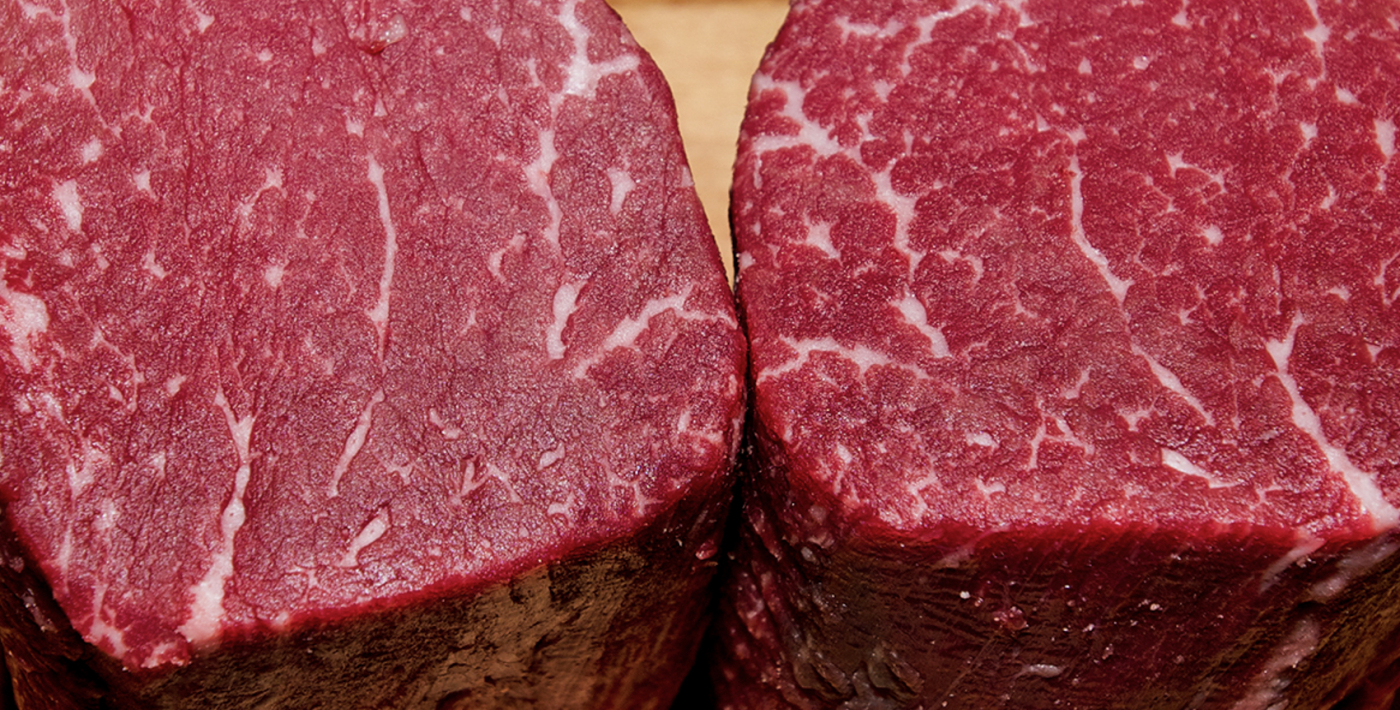
What’s your Beef? Knowing your Kobe from your Kagoshima
Derek Guthrie savours Japan’s premium grade beef, but asks: do we really get kobe?

Derek Guthrie savours Japan’s premium grade beef, but asks: do we really get kobe?

It’s no longer enough to know that Wagyu beef is Japanese, tender, and delicious. You need to bone up on Kobe, that rarest of rare meats. It commands such a price I’m starting a Kobe Breakfast Klub to tempt oligarchs and potentates away from their gold leaf lunches. The amuse bouche will be a mummified lark’s tongue.
When I first started visiting Kyoto, Japan’s gastronomic nirvana fifty miles from Kobe, I returned to London with tales of the finest beef known to mankind, of how only the smallest portions were required to appreciate the fabulous marbling, its rich taste and melting consistency. Of the orgasmic satisfaction to be had from tiny morsels actually dissolving on your tongue. It’s up there with hagashi toro, the best tuna cut. And sex, obviously.
Like Sir Francis Drake with his Peruvian potatoes, I was received back in London with a mixture of mirth and scepticism. Now we’re serving steaks of it at £150 a pop.
London’s Evening Standard was, recently, engorged in food-porn mode, extolling Kobe as “intoxicatingly delicious and intense… a flow of rich buttery sensation above and beyond its actual fruity flavour… weird and delectable in very small quantities”.
The problem to date has been that very little actual Kobe beef is produced
That may well be, but the problem to date has been that very little actual Kobe beef is produced. Hyogo prefecture is the only place in the world it can be butchered from purebred pedigree strains, fed on specific grains and grasses. There’s never been enough to export, which was why, until 2012, nobody outside Japan got any, even if your menu claimed otherwise. Every animal, every cut, is numbered and accounted for by distributors. (Kobe mythology, incidentally, has cows seduced by music and massaged with beer. The reality is somewhat different. The cattle I saw years ago were standing in pens unable to graze openly, a form of animal husbandry now frowned upon.)

The real deal: Japanese Kobe beef
Thanks to the accelerating demands of globalisation, and the 100% absence of Kobe beef outside Japan, Wagyu became the go-to name for high-end Japanese beef – but it’s a confused cover-all term. Wagyu implies Kobe, but Kobe is only a very small, meticulously regulated part of the picture.
As a result, Wagyu has been bastardised, much like the UK’s “Salt Marsh Lamb” and “Aberdeen Angus Beef”: quality products governed by specific rules and regulations circumvented by wily meat producers. Wagyu is unregulated as a term outside Japan and can mean, at best, a marriage of genes further up the breeding line, at worst, nothing. Which is tragic, as the real stuff is magnificent. In the meantime, “Wagyu” burgers are available at Aldi and Asda supermarkets.
Now there are miniscule quantities of real Kobe beef being made available to the West. In Las Vegas, Steve Wynn’s eponymous casino has some; importers in Monaco and Switzerland can’t get enough; and here in London, that Evening Standard review was for Engawa in Soho, whose portions are flown over on golden doves, each sliver wrapped in gossamer, fanned by little eunuchs. (Probably).
The manager at Engawa is ex-Nobu, a restaurant which has been serving up refined ingredients in a combined Japanese/American/Peruvian manner to a high rolling clientele for over 20 years. In among Nobu’s famous blackened cod and lobster ceviche you will see Wagyu – but only from Kagoshima, airmailed to London from Kyushu Island. There’s no central buying policy in Nobu Matsuhisa and Robert de Niro’s global restaurant chain, and thus far only the Hong Kong branch appears to be serving Kobe. So what’s the beef in London?
In Japan, this debate largely passes most people by. Beef has never been an important part of the diet
It’s served several ways at Nobu, starting with sushi: exactly what it sounds, slivers of beef on vinegared rice with wasabi, tasty but an acquired sensation in the mouth. Then comes thinly sliced tataki, seared but rawly rare inside; sukiyaki; and “steak”: tiny squares of all but raw beef with yuzu. Three sauces on the side – Peruvian anticucho, Japanese mustard, and ponzu – always seem extraneous to me; the meat itself is quite sufficient. The taste is better, sweeter, than British beef, the consistency softer as the fat is more evenly marbled. Nobu’s high price is not too insane, all things considered. This is a high end, quality product.
In Japan, this debate largely passes most people by. Beef has never been an important part of the diet. (Kobe beef was discovered almost by accident by a visiting Englishman). It’s their obsession with seasonality, quality and authenticity that has kept Kobe production rigidly protected for decades, and why it remains one of the sensations of Kaiseki cuisine: those multi-course banquets which celebrate seasonality almost to the day, never mind the month. A walk through Kyoto’s vibrantly colouful and aromatic Nishiki Food Market proves that.
In the West we have endured so many food scandals, it’s easy to see why premium ingredients are often shipped across the world at great expense, free from foot and mouth or BSE. Taste and texture is an added bonus.
In London, for every Engawa and Nobu there are too many establishments choosing deception over provenance. It would be better if they were the rule, and not just exceptional. C
The author acknowledges the landmark article of Larry Olmstead in the December 2012 edition of Forbes Magazine, Food’s Biggest Scam: The Great Kobe Beef Lie